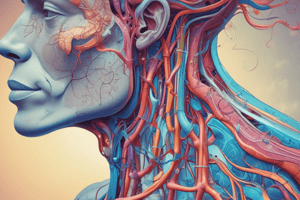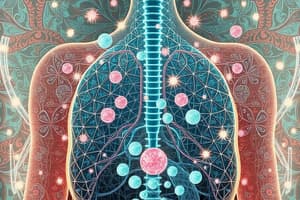Podcast
Questions and Answers
What drives the internal respiration process in body tissues?
What drives the internal respiration process in body tissues?
- Active transport mechanisms
- Concentration gradients of gases
- Partial pressure gradients (correct)
- Oxygen binding affinity changes
Which statement accurately describes the role of the pulmonary artery?
Which statement accurately describes the role of the pulmonary artery?
- It carries deoxygenated blood from the heart to the lungs. (correct)
- It transports carbon dioxide from the lungs to the heart.
- It carries oxygenated blood to the lungs.
- It facilitates gas exchange in the alveoli.
Where does external respiration primarily occur?
Where does external respiration primarily occur?
- In the lungs' alveoli (correct)
- In the capillaries surrounding tissues
- In the pulmonary arteries
- In the body's tissues
What happens to oxygen in the blood when its partial pressure is around 100 mm Hg?
What happens to oxygen in the blood when its partial pressure is around 100 mm Hg?
How does carbon dioxide primarily move from the tissues into the blood?
How does carbon dioxide primarily move from the tissues into the blood?
Flashcards are hidden until you start studying
Study Notes
Gas Exchange Overview
- Oxygen absorption is a continuous process occurring in the alveoli, where it enters the bloodstream and is replenished by breathing.
- Regulation of oxygen concentration and partial pressure in the alveoli depends on the rates of absorption into the blood and ventilation.
External and Internal Respiration
- External respiration involves gas exchange with the environment, occurring in the alveoli of the lungs.
- Internal respiration is the exchange of gases that occurs within tissues.
Mechanisms of Gas Exchange
- Gas exchange relies on simple diffusion; no energy is required for oxygen and carbon dioxide movement across membranes.
- Oxygen diffuses from alveoli into the blood, where it predominantly binds to hemoglobin in red blood cells.
- At the same time, carbon dioxide diffuses from the blood into the alveoli.
Pulmonary Circulation
- The pulmonary artery transports deoxygenated blood from the heart to the lungs.
- It branches into pulmonary capillaries, forming a respiratory membrane with the alveoli to promote gas exchange.
Internal Respiration Process
- In tissues, the partial pressure of oxygen in blood (approximately 100 mm Hg) causes oxygen to dissociate from hemoglobin and diffuse into the tissues.
- As hemoglobin releases oxygen, blood color changes to a darker burgundy before returning to the heart.
Carbon Dioxide Transport
- Higher partial pressure of carbon dioxide in tissues than in blood facilitates the diffusion of CO₂ into the bloodstream.
- Carbon dioxide is transported back to the lungs in three forms: bound to hemoglobin, dissolved in plasma, or as a converted compound.
Studying That Suits You
Use AI to generate personalized quizzes and flashcards to suit your learning preferences.




